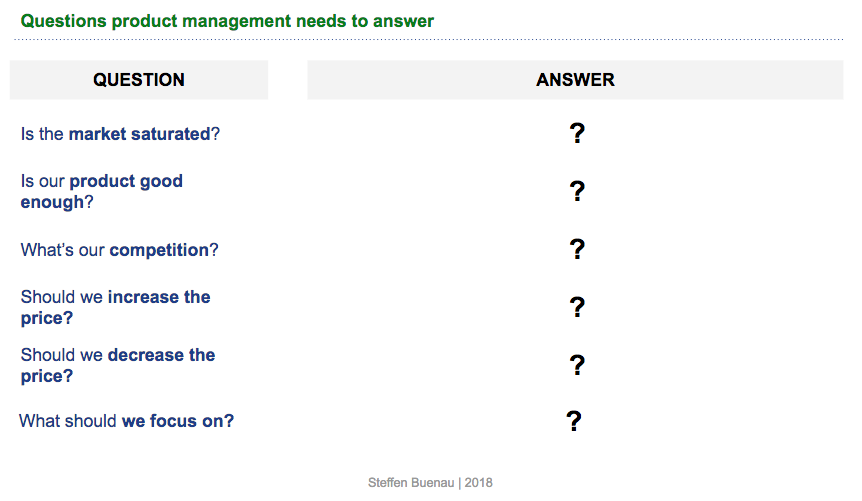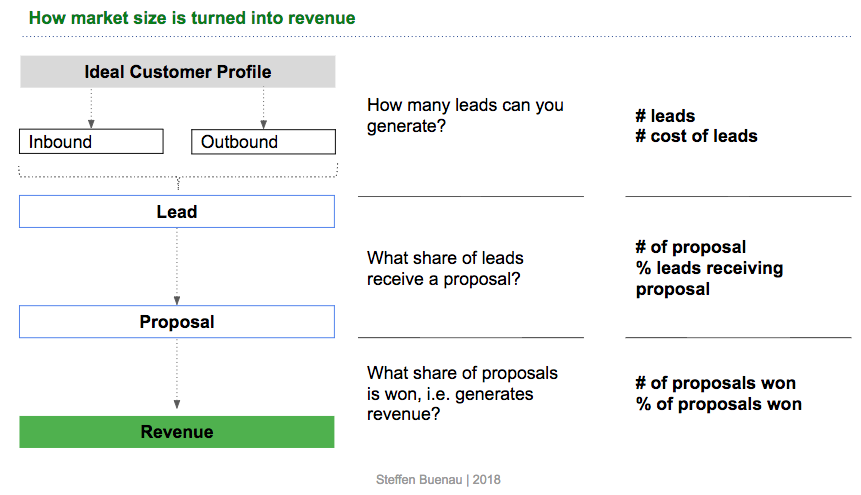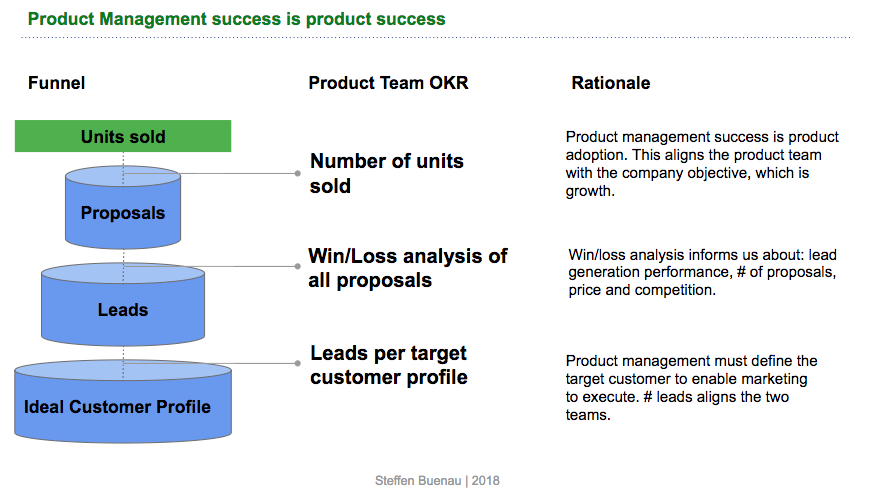Defining OKRs or KPIs for Product Management is difficult. Arguably, however good goals are important since product management teams can easily be drawn to the engineering side, the sales side or the marketing side and therefore need clear goals to prioritise actions.
Product Management goals depend on company stage
The first step is to clarify where you are in the product life cycle. In the following we assume that the team has a product in the market. In this case there are two options. Case 1: you want to sell more product to existing customers. Case 2: you want to sell the existing product to more customers.
Example: Let's say you are selling a tool to manage your suppliers. you might want to add an additional feature to handle supplier complaint management. If you plan to charge more for this additional feature than this would be case 1. You plan to sell more to existing customers.
An example of case 2 would be that you have so far focussed on selling the tool to car manufacturers in the UK. Now you want to sell the same tool to car manufacturer in Germany. This would be case 2.
The two ways of growth
For the purpose of this article we focus on case 1. The key characteristics are: the product is mature but the market is not saturated. Whether these two assumptions are true will also be indicated in the metrics we are defining.
A good starting point on defining the size of the market is my article on Unit Economics for Market size estimations.
Product success is the indicator of good product management
Product Management teams have the goal to make a company successful by ensuring product success. Product success is unit sold. More precisely it is the contribution margin (= per unit revenue - per unit cost), however here we assume that the product is mature, i.e. a price is set and hence focus on units sold, not revenue.
But, we are not ignoring price - in fact whether we should decrease/increase the price is a key output of the metrics we are about to set.
In addition to the pricing element, the OKR system we are designing provides the source for key (company) management questions.
Good OKRs help us define the answer for these questions
OKRs for Product Managers need to follow the funnel
Since we have defined the context and the questions we need to answer we can now design the OKR system.
The rational is simple:
Unit sold (product success) come from proposals to potential customers. Specifically, units sold results from won proposals.
Proposals come from companies or people for whom the product could be relevant. These companies or people we call leads.
Leads are part of the ideal customer profile whom we have targeted either through outbound or inbound marketing activities. Outbound means we approach them first, for example through email or targeted advertisement. Inbound means they come to us, for example through product searches or referrals.
Product Management OKRs along the Sales Funnel
How to use the OKRs
OKRs along the sales funnel align the sales function and the marketing team but go beyond that into product specific insights through the incorporation of win/loss analysis.
The picture is simple:
Lead generation: product management is in charge of defining the target customer, price and features. In the assumed scenario this has already happend. Product teams now need to provide marketing with all that it needs to be able to reach the target customers effectively. These could be classic buyer persona's or things like useful content for the target market or participation in webinars. The problem is that this is not measurable.
Because we are need a measurable metric plus we do not want to measure activity but outcome the most relevant product OKR would be #of leads. Clearly, the execution and messaging is handled by marketing but two align the two teams in the interest of the company #leads is the most forceful tool.
Win/loss analysis: Since we assume a company set up with a Sales Team the conversion from lead to deal is carried by the Sales or the Sales Development Team. In other set-ups like in-app purchase business models these metrics could be carried by a revenue lead. I recommend to listen to the Episode "Revenue is Product Management" by the Mind the Product podcast.
A win/loss analysis will result in three key insights for the product team:
How many proposals do we have? If we do a win/loss analysis on all proposals we will automatically track the number of proposals that we have and understand from which customer profile they come from. This helps the product and the marketing team judge the effectiveness of particular marketing measures.
What share of proposals do we win and why? We care less about won proposals than we think. Generally, we want to know two things: are the won proposals enough to hit our overall volume goal, why did we win them and from which customer profile are they. The reason for winning we want to capture and use as part of our marketing message to the same customer profile.
From a pricing perspective, we want to understand if we could have sold the product to the same customer for a higher price.
What share of proposals do we loose and why? This is the most interesting insight for product management. Did we loose to a competitor or did the lead end up not buying anything for the job our product is meant to get done? If that's the case we might not be solving a problem that matters.
Did the customer not have a budget/means to purchase the good? Than we might need to change our target profile.
Did the customer chose a competitive product? If yes, this could mean the market is saturated or we are not doing a good enough job presenting our unique selling points or product advantages.
Did the customer not buy because of the price? If yes, why and how much lower would the price need to be for this segment of leads to win the proposal.
Beyond the product team - how do our OKRs help the company?
By following this metric or OKR structure we not only guide the product team on what is important: generating more leads that fit the profile, or winning more proposals we also deliver key insights to the management in general.
Based on the data resulting from the OKRs we can help the management answer the questions we posed above:




